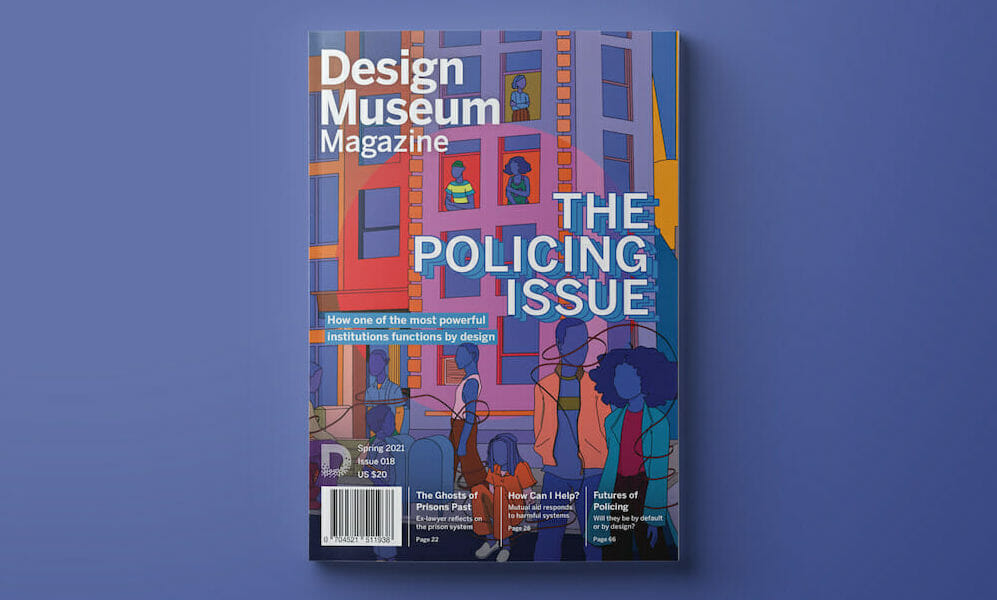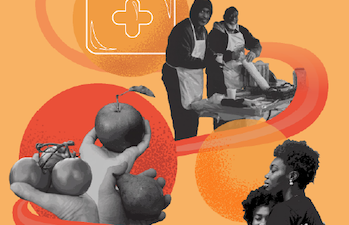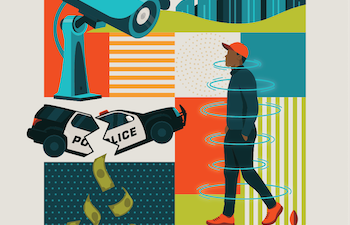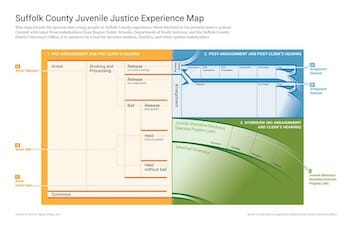The Policing Issue
How one of the most powerful institutions functions by design
A special Design Museum Magazine issue on how one of the most powerful institutions functions by design

The Policing Issue includes thoughtful contributions from 20 BIPOC writers, artists, and researchers, to challenge and explore the relationships, limits, and futures between design and policing, tackling the unspoken truths and history of policing while being a person of color in America.
In America, Black people are three times more likely to be killed by police compared to their white counterparts. Furthermore, one in three Black men can be expected to be incarcerated versus one in 17 white men. It is no myth that police brutality and racial profiling has taken place in America for centuries but there is rarely an explanation to why it continuously occurs. The methodology and design of policing, as well as our collective narratives about safety, security, and community, are informed by our beliefs about policing and its place in our lives. The design concepts behind architecture, urban planning, environmental graphics, lighting, transit systems, digital devices, apps, schools and workplaces all intersect with policing in manners invisible to those privileged by its inner workings.
This latest issue showcases how design can be used to deeply oppress people of color, whilst also opening up non-BIPOC readers’ eyes to the duality of benefits versus disadvantages exhibited in design. In addition, the issue takes a deep dive into the root cases, history of design, and its subsequent intersectionality with policing. Read the full press release.
Published May 2021
Language: English
88 Pages
$20
Add to cart to purchase copies of The Policing Issue
Subscribe to receive your copy of The Policing Issue and each biannual issue of Design Museum Magazine shipped to your address
CONTENT
Letter from the Editor
By Jennifer Rittner
How Can I Help? (Preview)
By Shanti Mathew and Stephanie Yim
Designed for Harm (Preview)
By Timothy Bardlavens and Jennifer Rittner
Plato’s Cage (Preview)
By Ajay Revels and Jennifer Rittner
Design Activism: A Dialogue on Protest, Policing, & Demanding the Future We Need
Futures of Policing (Preview)
By Jamie McGhee
PRESS RELEASE
Special Edition: Design Museum Magazine’s Policing Issue Explores How the Most Powerful Institution Functions by Design
BIPOC contributors challenge and explore the history, relationships, limits, and futures of policing
(Boston, MA – April 2021) — Design Museum Everywhere, creator of the groundbreaking exhibit We Design: People. Practice. Progress, is placing design at the forefront of the Black lives and policing conversation with the release of a special edition of its Design Museum Magazine, The Policing Issue: How one of the most powerful institutions functions by design. Guest edited by writer and educator Jennifer Rittner, this powerful issue includes thoughtful contributions from 20 BIPOC writers, artists, and researchers, to challenge and explore the relationships, limits, and futures between design and policing, tackling the unspoken truths and history of policing while being a person of color in America.
In America, Black people are three times more likely to be killed by police compared to their white counterparts. Furthermore, one in three Black men can be expected to be incarcerated versus one in 17 white men. It is no myth that police brutality and racial profiling has taken place in America for centuries but there is rarely an explanation to why it continuously occurs. The methodology and design of policing, as well as our collective narratives about safety, security, and community, are informed by our beliefs about policing and its place in our lives. The design concepts behind architecture, urban planning, environmental graphics, lighting, transit systems, digital devices, apps, schools and workplaces all intersect with policing in manners invisible to those privileged by its inner workings. This latest issue showcases how design can be used to deeply oppress people of color, whilst also opening up non-BIPOC readers’ eyes to the duality of benefits versus disadvantages exhibited in design. In addition, the issue takes a deep dive into the root cases, history of design, and its subsequent intersectionality with policing.
“We are hoping to reveal some of the ways in which models of dominant-cultural supremacy frame design practices, and have entrenched some of the same oppressive inequities produced by policing,” said Guest Editor Jennifer Rittner. “You cannot change what you cannot see. This issue unpacks the current state of the system, exposing the creation and design of systems that perpetuate racism. It is a call for change.”
The recent increased awareness of racial inequalities and the demand for a reckoning following the murder of George Floyd created a catalyst for The Policing Issue, but it has been on Rittner’s mind since the murder of Amadou Diallo by NYC police in 1999. She explains, “This issue has been a long time coming. And the Design Museum, an inclusive organization built on giving designers a platform, is the right partner at the right time. The collaboration resulted in writers and artists being able to freely express themselves, honestly, and openly from a design and, more importantly, a Black and POC vantage point. My hope is that this special publication creates a new model or inspires others to create something that has both equity in this process and the product.”
From the cover illustrations to the interior content, every aspect of the publication uses a visual and spoken design language to communicate and evoke a visceral reaction, engaging the reader to more closely examine the world in which they live. At first glance, the cover art by 20-year-old illustrator and painter Blacksneakers, appears not to be about policing at all, but rather depicts a utopian hope for the future of what an urban space without policing looks like. Rittner further explains, “It is messy, real and absent police in ways that make the greatest statement about what the BIPOC community wants for our future — the freedom to live and to be whole.”
Inside, the 88 page special edition is filled with riveting articles, colorful illustrations, and imagery from multiple artists of color and notable BIPOC voices and contributors, including A.D. Sean Lewis, Ajay Revels, Annika Hansteen-Izora, Ariel Sinha, Blacksneakers, David Lamb, Dustin Gibson, Ivy Climacosa, Jamie McGhee, Jennifer Rittner, Jon Key, Lamees Rahman, Liz Ogbu, Myahn Walker, Niki Franco, Sarah Fathallah, Shanti Mathew, Sophia Richardson, Stephanie Yim, and Timothy Bardlavens. Featured articles address topics from how the design of physical objects currently in use by officers perpetuates unjust practices, to the ways in which the design of prisons, and even the design of protest movements, all play a role. Special highlights include:
- A visual essay on the tools currently in use by police, by Timothy Bardlavens
- Unraveling the links between the design process and policing, by Sarah Fathallah and A.D. Sean Lewis
- The economics of policing, specifically bonds and prison design, by David Lamb
- Exploring how mutual aid designs community, by Shanti Mathew and Stephanie Yim
- Interviews with activists, reformers, and designers about their visions for the future of policing, by Jamie McGhee
- An online exclusive case study about Agncy’s work studying the role of complex justice system maps and documentation in Boston, by Augusta Meill and Janelle Ridley
“This is a continuation of a long journey of using our platform to elevate Black and Indigenous People of Color voices and our commitment to change,” said Founder and Executive Director of the Design Museum Everywhere Sam Aquillano. “This issue is more about learning and listening to the Black community, who are dramatically disproportionately impacted by the entanglement of policing and design.”
The special edition marks the first time the Design Museum handed full creative control to a guest editor for their quarterly publication. Funded by donations on Kickstarter, 205 donors pledged a total of $21,235 to bring this important project to life, and to ensure all contributors were paid for their work, and for sharing their lived and learned experiences.
Printed on archival paper, The Policing Issue will be mailed to subscribers and Museum members on May 4, 2021. Dedicated to continuing this important conversation, the Museum will publish special online content, host roundtables, and feature contributors on Design Museum’s podcast, Design is Everywhere, to go deeper, contextualizing and elaborating on their pieces. Subscriptions to the quarterly publication are available on the Design Museum website for $36/year and include this special issue — individual copies are also available for purchase without a subscription on Design Museum Everywhere’s website.
KICKSTARTER BACKERS



Charles Austen Angell
Chris Clare
Christine Abbate
David Pitcher
David Silverman
Deb Aldrich
Gabriela Mier
George White
James Spence
Jess Charlap
Josephine Holmboe
Larry Rodgers-Geng
Leah Ben-Ami
Ryann Hoffman
Sarah Fathallah
Ashley Dunn
Buck Bard
Cia
David F. Roeber
David Morgan
Denise
Douglas Sanchez
Janet Stephenson
Jeanie Lai
Jennifer Berk
John Wix
JOSE DOS SANTOS
Juhan Sonin
Kate Murphy
Laura Hellinger
Megan Cronin + Chris Faust
Poppe Tsunami
Rachel Lovinger
Rachel Mutschler
Richard Banfield
Sarah Marie Coppola
Scott Kirkland
Steve Aquillano








